“If a film is working, you’re forgetting about everything else….”
TyRuben Ellingson is responsible for your dreams. As a cinematic visual effects art director and conceptual designer, he creates the monsters and galaxies and eerily beautiful landscapes through which your imagination roams in the flickering light of a movie theater … or in the deepest folds of time and image that your brain explores while you sleep.
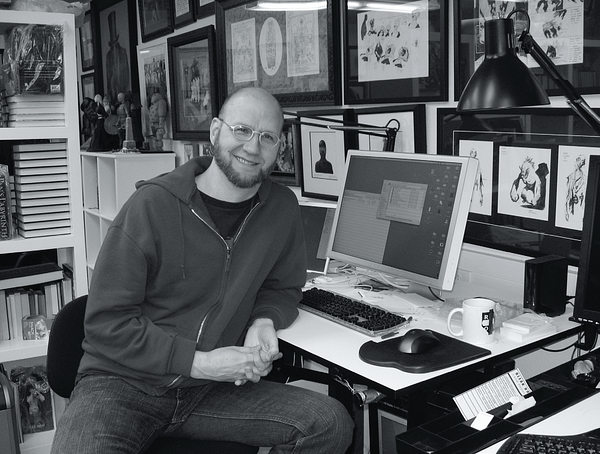
Born in Minnesota, he started his career making cardboard models (“investigations”) in his father’s art studio. Shortly after earning an MFA from Southern Methodist University, he went to work for George Lucas’s Industrial Light and Magic as a visual effects (VFX) art director. There he was part of the team that devised innovative special effects in movies such as Jurassic Park, Star Wars: A New Hope, and Disclosure. He has also designed for director Guillermo del Toro and the Blade series of films, and while working for James Cameron at Lightstorm, he designed the vehicles that helped remap cinematic and imaginative history in the movie Avatar.
In 2015, former Associate Editor Matthew Phipps sat down with Ellingson at Virginia Commonwealth University, where Ellingson teaches in and chairs the department of Communication Arts. Their talk flew through cinema as an art form, to Ellingson’s personal inspirations, the practicalities of networking, and how to balance artistic vision with a director’s ideas — and why sometimes it’s best not to live in Los Angeles.
We present here the full interview in a special online format — with additional illustrations both from TyRuben’s movie work and from projects he has undertaken for his own pleasure — from our 2016 “Maps & Legends” issue.
This interview is available, in slightly different format, on Medium–where you’ll also be able to clap to show your enthusiasm for it.
****************************************************************************************************
Broad Street: You grew up with a printmaker and an art professor for a father. How involved was he in your early formation as an artist? Did he guide you towards the field or caution you against it?
Ellingson: Well, looking back over the course of my entire life, he was the most influential artist, and the most influential thinker, and kind of the most relevant model of any personality I’ve encountered. When I was drawing as a very young child, he never connected the dots too strongly between my investigations and any kind of expected outcome. He didn’t push me, as it were, toward being an artist or a designer. Rather, he just responded to my interests.
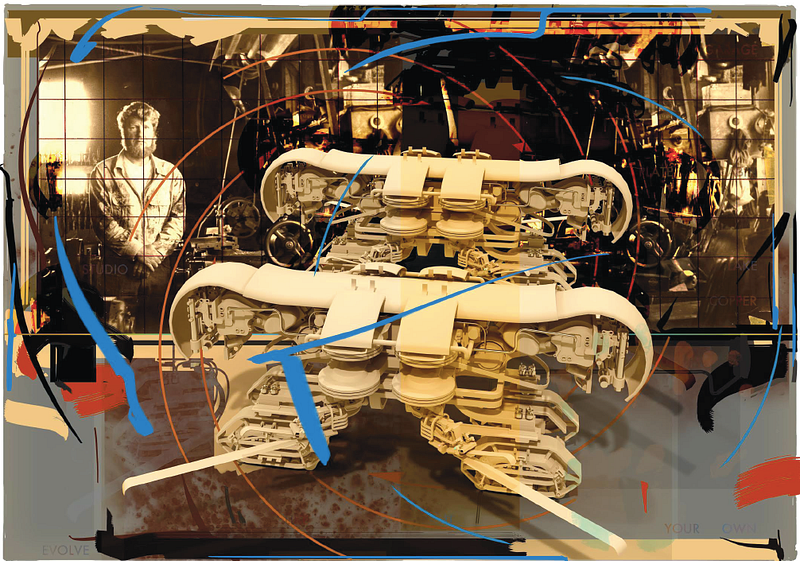
What were some of your other early influences, and how did you get interested in working on movies?
I was a big movie fan very young. I can remember that really early on, probably when I was seven, I saw Frankenstein, and it was so amazing, because I didn’t even know they made movies like that. Everything about it was scary, and cool, and weird, and it seemed so … stimulating. I incorporated those ideas into my drawings and into my imagination. It’s a pattern very similar to many artists’.
One of my interests was always that kind of supernatural universe where people were having dynamic experiences. You know, Frankenstein’s monster is made in a lab, and the lab is filled with all kinds of electricity. I was stimulated by the technology and the idea of putting dead people together and creating life. It made me think, even at a young age, That’s creepy but would that work, and how would it work, and couldit work? It was an expansive kind of experience. I also liked, as most children do I guess, the stimulation of being afraid. It’s very seductive; it makes you giddy in a kind of horrific way, if there is such a version of giddy horrificness.
The real game changer for me was, in 1968, Stanley Kubrick’s 2001: A Space Odyssey. I saw it at a young enough age and an impressionable enough age that suddenly cinema, the ideas that go into cinema, seemed like a logical extension of art. I think that was more a cultural norm of the 1960s and the early 70s. These important filmmakers were trying to transcend form and give it the same relevance as the historical kinds of art that we were all exposed to — you know, elevate it to that stature.
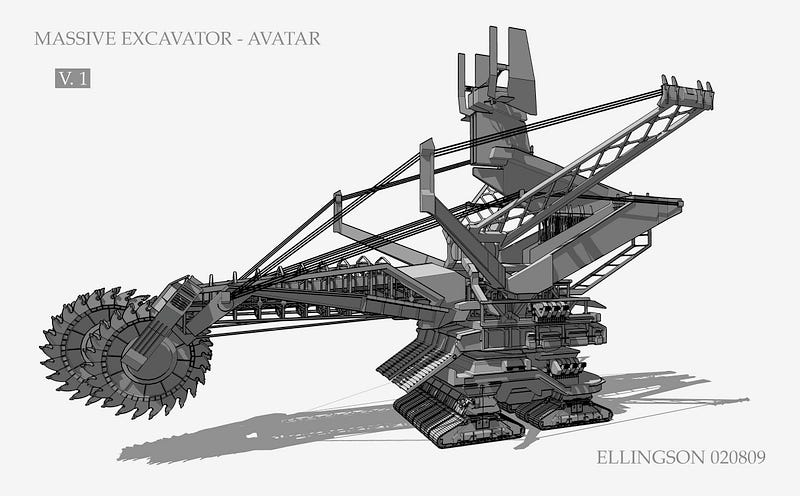
2001 was really about a shift in perspective that had to do with the potentiality of the form of cinema. It was like no movie I’d ever seen. The film is relentlessly visual, and at the age I was at, it was oppressive. I remember by the end, when we’re in the infinity sequence, I literally got motion sickness. I’m sure I was hyperventilating.
There’s one moment when Bowman’s eye is reflecting the infinite spectrum, and I looked over my shoulder. The audience’s eyes were reflecting Bowman’s eyes. It was too trippy. I didn’t go to the theater for about two years after that, because it so freaked me out. It was the first experience I had in my life where, afterward, I questioned my father about the meaningof the film, and he couldn’t explain it to me. I’d never seen my father not provide me a ready answer to any question I’d ever had. He was saying, “Well, you’ll have to think about it.” And it seemed that there was something there that was so primordial and futuristic, that even at that age of nine or eight, it was speaking to the foundational aspects of my self.
Were you already imagining how your own skills as an illustrator would fit into such a project? What sort of a role did you envision yourself taking back in those formative days?
Shortly after I saw 2001, I saw Life magazine or something that ran a pictorial on Kubrick and the film — or maybe it was even something [filmed] I saw, a behind-the-scenes, a making-of. Somehow I found at that there were artists that were working to assist the director in making that happen. So I think even by that time, at eight or nine, I knew there were creative factors that went into the creation of these things, and I started to draw my own space ships, and I became really interested in how people that made images of space would do it — how spacecraft and astronauts and space suits worked.
And that was all happening in real life too. The manned space program was well underway. NASA, the early Apollo missions, they always had artists doing renderings of what it’d be like to be on the moon, or how the LEM [lunar excursion module] comes off of the space capsule. I was aware that there was a lot of additional creative horsepower behind the scenes, and I think that was always running through my mind.
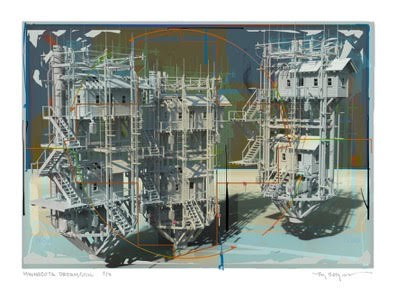
Your first step was going to art school. How did your work and your interest in cinema fit into the world of a fine arts program?
This is a question I actually speak to my students about. The world of art — it does have strata. There are always different schools, different camps, different movements that establish these sorts of corrals around ideas or concepts.
Luckily for me, because I had an artist father, I’d been exposed to these concerns, so I’d been able to formulate a certain kind of argument, or at least reference points.

I had the ability, looking back, to kind of dual-track my interests. I connected my interests in science fiction design, in science fiction and creatures, to cinema, and left them attached to cinema, and then I took my more studio-driven endeavors and I connected those to the world of the fine arts. There was a line in between, there was a demarcation.
“I knew that I was capable enough as an artist to stay busy with my own investigations, but I started thinking, You’re gonna have to try this once. You’re gonna have to make an effort and see how far you can run with the ball.”
The line became a growing source of frustration for me. I’d done the painting thing for a long time. The mid-eighties, when I was in art school, was kind of a fickle time as far as the arts go. I really didn’t feel like my voice was relevant — either for me or for my audience. I was falling out of love with a lot of the ideas that I’d been working on for, by that time, a decade. At the same time, the idea of working in Hollywood seemed inescapable to me. When I say that, I mean it fundamentally started to haunt me.
I started to think, Am I going to be able to survive creatively if this [fine art] is the totality of what I’m going to be doing? It didn’t grow out of a place of discontent as much as a place of fear. I knew that I was capable enough as an artist to stay busy with my own investigations, but the closer I got to graduating, I started thinking, You’re gonna have to try this once. You’re gonna have to make an effort and see how far you can run with the ball.
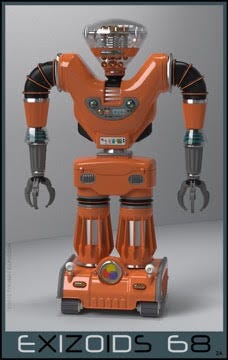
Just a few years out of graduate school, you started working at George Lucas’s Industrial Light and Magic. How did you make the move from fine arts into cinematic design, and what happened next?
At the time [the mid-1980s], the idea of networking was kind of new. Suddenly there was this idea that you could meet people, and through contact with them you could expand the number of people you knew, and you could progressively find avenues to whatever outcome you were hoping to achieve.
So I started to network — I really did network my way from Dallas, Texas, to Northern California. I’d meet people at parties and I would ask them, “You don’t know anybody that works in film, do you?” After a while, I just started doing that with everybody I’d meet, and pretty soon I met a guy who knew some guys that shot films locally. And through that I met some other guys who had a connection to Lucasfilm, and eventually I found a connection all the way.
When I left ILM in 1995, I’d been there for only five years. People were really mystified, because no one ever left the facility. Jurassic Park had come out in ’93, and we’d done Casper the Friendly Ghost, The Flintstones. We were moving forward with these bigger and bigger pictures; the digital/visual effects bubble was just blowing up.

For me [leaving] was really getting closer to my ultimate goal, which was to design things from my [own] imagination relative to the story the director was trying to share, and then get those things on screen with the greatest amount of fidelity.
And so once I got that shot — it was for Mimic; I designed the signature creature for that film — I just didn’t even hesitate. I went. And that’s how I got started on my conceptual design period, which has been, for me, just bliss. I mean, I love what I do, I love that work, and I’m sure I could be happy doing conceptual design forever.
So now you’re established in the field. What kinds of ideas does a director bring you for a project? How fully formed is the idea when it’s presented to you?
The range is huge. You can have a director that has basically a concept, and they’ll say, “Here’s some bones, can you put some flesh on them?” Other times there’ll be a huge number of constraints. Usually, the director has written them down in words, but in the case of del Toro or James Cameron, they both draw very well. So they may come to something and say, “Here’s what I have, it’s gonna be in this sequence, it kind of looks like this, I kind of imagine it this way, it has eyes …” So you get a rough draft. You’re kind of working to embellish or elevate or amplify the essence of what you’re being provided.
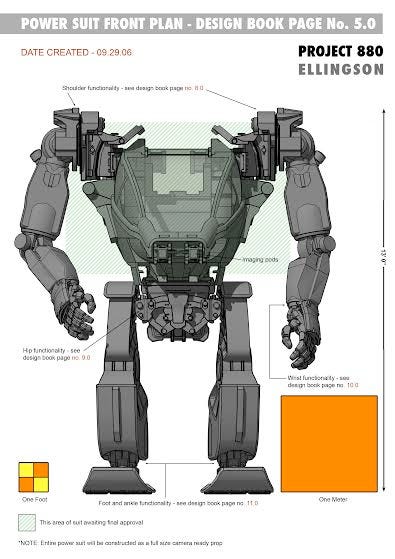
Do you ever have the sense that your designs are having an impact on how a character develops for a project, or even how a story plays out?
In the best cases. Other times it just adds a sense of grounding for the actors. On Avatar, they built a full-scale AMP [Amplified Mobility Platform] suit, a robotic suit, and Jim was adamant from the beginning that the actors had to interact with it. And when Quaritch is speaking to Jake and he’s talking about the difficulties of war and the reality of Pandora, Quaritch goes to that AMP suit prop and checks the hydraulics like a pilot would on a fighter jet. Then he crawls up in there. I know the actor practiced a great deal to know hw to climb in in a way as though it was second nature to him. So yeah, design has an impact — it can.
“I really did network my way from Dallas, Texas, to Northern California.”
When you come into a project to discuss a director’s predetermined aesthetic, how do you find inspiration or strategies for working within the guidelines already in place?
Well, there’s two parts to that. One part: if I have to define myself ultimately as a designer, it’s that I am a designer of shapes. Shapes and silhouettes. Because cinema happens very quickly. The audience has to read objects with great fidelity in a very short period of time. That’s what they’re used to — that’s the process of watching a movie. If you look at the original Star Wars,the X-Wing fighter is never going to be confused with the TIE fighter, which is never gonna be confused with the Millennium Falcon, because each of them has a strong shape. They’re what I call informed silhouettes. Your eye can read them once and remember them, and you won’t confuse them, and they actually have a persona as well. The design has a character. So that’s where I focus my primary design research.
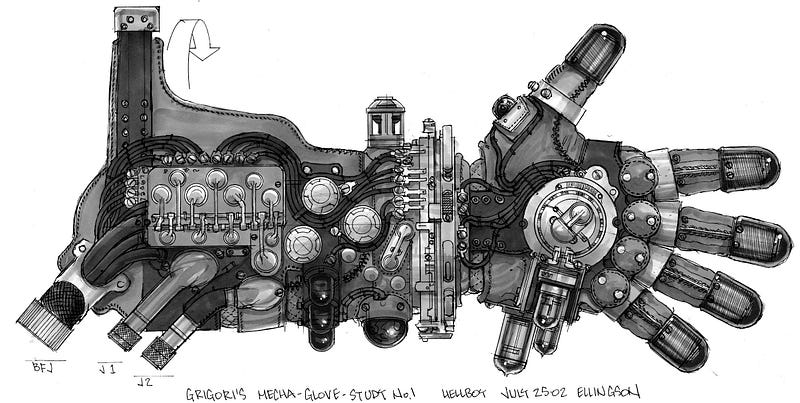
The other piece is context. And for context you need to understand the overall narrative. The narrative reality of any film is going to need to be supported by the designs that you’re asked to create. The first day you’re on the show, you’re given a script.
In some cases, as with Guillermo del Toro, we actually have a script reading where he’ll interrupt the reading and say, “Hey, what I’m thinking here is this.”
In some cases, what I mean now by research is actual research. You’ll actually have to go look at some books, go on the internet, get some kind of awareness of what the larger landscape of the movie is going to look like. Oftentimes there are other artists working, and you can see what they’re doing. You’re starting to see the larger reality of the film more clearly.
“If you live in LA, you become one of the usual suspects. If they have to bring you in, you’re treated differently.”
What are some of the differences between working for a big company like ILM vs. working for an independent director like Guillermo del Toro?
ILM was like a bullpen. We’d have films come in, and there would be a big meeting of VFX art directors, they’d say, “Let’s get some robots, let’s see some spaceships.” That competition is very intoxicating, but it’s more strategic, and in many ways it wore on me. When I did well, it made me feel really guilty, because maybe somebody else wanted to do those things; but if I didn’t get a chance, I’d feel really disillusioned, and I’d think, “I’m going to work extra hard next time.” It was a very good place to grow, a dynamic environment to evolve in, but once I was working more as someone chosen by the director’s interest in my particular involvement with the picture, it really liberated a more refined or more insightful and more dynamic kind of design, both process and outcome. I worked well with that model.
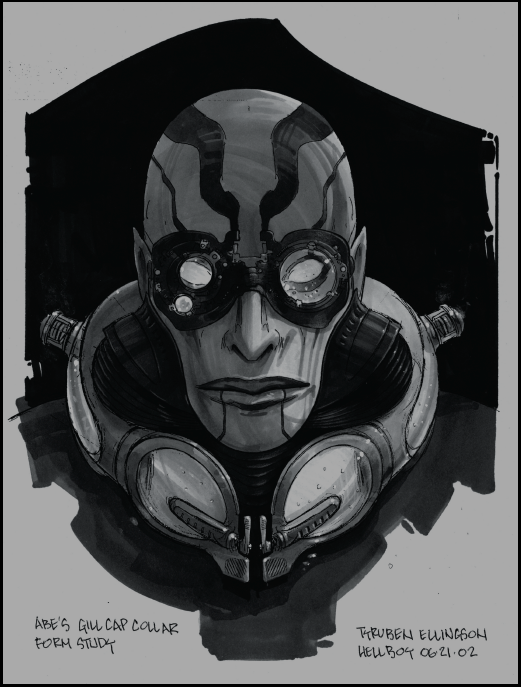
Guillermo told me two things when I first worked for him: “Always work for the director, and never move to LA.” And the reasons are very specific: If you always work for the director, you get firsthand information, and you get the value of direct access to the source. The other piece is that, if you live in LA, you become one of the usual suspects. If they have to bring you in, you’re treated differently. They have to bring you in because you’re a more specialized commodity.
I really stuck to those ideas. In many ways, after leaving ILM my experience in what would be called the art department was somewhat unique and specialized, because I did always have access to the director and I always had specific tasks at his behest. Everybody was given their design assignments, and then everybody could have a good time. You walk into one room and there’s Wayne Barlowe, the creature guy, and he’s doing some cool reaper designs for Blade 2, and then there’s Mike Mignola, and he’s doing environmental design, and those are cool. It’s more like having a great potluck as opposed to trying to cook together at the same stove.
“I love what I do, I love that work, and I’m sure I could be happy doing conceptual design forever.”
How did your working relationship with James Cameron come about, and how has it evolved?
I met Jim when he was working on Terminator 2. I was still at ILM at the time. He was there kind of regularly, and I think my first encounter with him was probably something like, “Hey, this is Ty Ellingson, he’s one of our art directors.” I was probably wetting my pants, because I think Aliens (the sequel to the Ridley Scott film) and The Abyss are such extraordinary visual films. I really wanted to embrace that more adult, dramatic, graphic model.
Within a year or so of the Terminator film, Jim was at ILM on a commercial and I was assigned that commercial as an art director. At the end, I copied a bunch of my best work and wrote him a note that basically said how much I admired his pictures, and that if he ever had an opportunity for me to participate in one of his pictures, I would be very quick to do it. I put that all in an envelope.
As he was leaving the campus and getting into the car I said, “Jim, it’s been really great working for you, and I have this for you.” I was a bit nervous. I was still working at ILM and I didn’t want to look like a turncoat or something. But he just took it nonchalantly and put it under his arm and said, “Thanks for this, I’ll get back to you.”
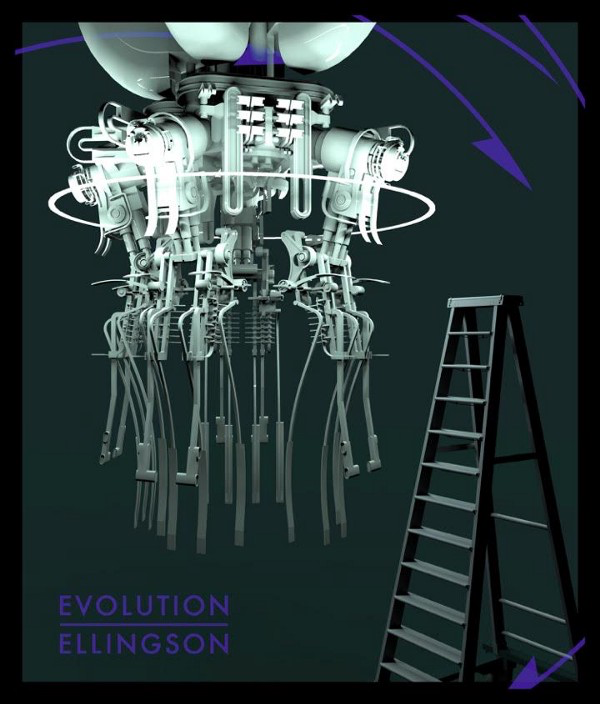
Years went by. In the early 2000s, I got a call from Lightstorm, his company, asking if I was available to come do some work on one of Jim’s projects — and I said of course. I flew down and did a few weeks on a project called Battle Angel, which hasn’t been made yet. But within two years of that I got a call to come work on Avatar as the vehicle designer.
I figured there would be a large art department, because I knew the scope of the project was huge. But there were only like six people. The biggest group was doing the animal life, doing the creatures of Pandora. Then there was a smaller group that was doing the flora, the landscape, the geography of the planet, the moons and all that stuff. And then there was me, just me, doing vehicles.
I spent three years working for Jim on Avatar. Jim and I met every ten days or two weeks, and then I went off to do the next round of drawings. That’s how it went. There’s only two vehicles that I didn’t design. All the mining equipment, the flying vehicles, the AMP suit — I did all of it.
“The greatest compliment I got from James Cameron is once when he said to me about one of my designs, ‘This doesn’t suck.’ That’s the bar.”
What was it like to interact with the director you’d hoped to work with for so long? What sorts of feedback did he give you?
The way he thinks about his films, the way he develops and creates films, is with one hundred percent laser focus. The guy is so engaged that you have to pay very close attention to everything he says, because it all comes from an informed place. His vision is very detailed and is based on a lot of his own knowledge. He’s a pilot, for example.
Even after years of meeting with Jim I found myself in a heightened state whenever I was around him. I like to make a joke: The greatest compliment I got from James Cameron is once when he said to me about one of my designs, “This doesn’t suck.” That’s the bar.
“People always ask me, ‘Does it kind of ruin it for you, knowing how things are done?’ And it really doesn’t.”
What does it feel like at the end of this process, when you see the finished product? What’s it like to see your creations on screen, interacting with the rest of the narrative?
Normally I’m involved only in pre-production, so the things I’m designing are often not even created until I’ve left the movie. Sometimes I’ll design a prop or something and I’ll actually see it by the time I leave.
When I saw Avatar in the theater, it was after a gap of a couple years. I remember really enjoying the film — until they started to attack the Hometree.
The horrific nature of violence, the incompatibility of these technologies and nature … it did really resonate.
People always ask me, “Does it kind of ruin it for you, knowing how things are done?” And it really doesn’t. It’s pretty easy to put yourself in the audience and enjoy that process. If a film is working, you’re forgetting about everything else.
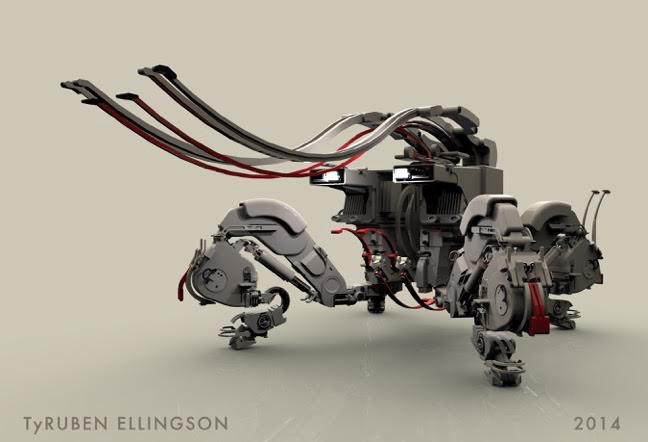
****************************************************************************************************

Matthew Phipps, who interviewed TyRuben Ellingson, is a past editor of Broad Street and a graduate of VCU’s MFA program in creative writing.
He also interviewed Tony-winning costume designer Paloma Young for our themed issue “Hunt, Gather.”
****************************************************************************
Like what you’ve read here? Then please follow Broad Street on Facebook and our website.









